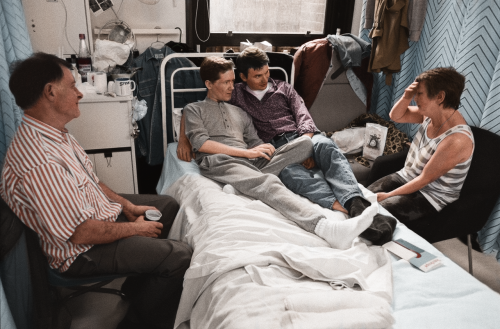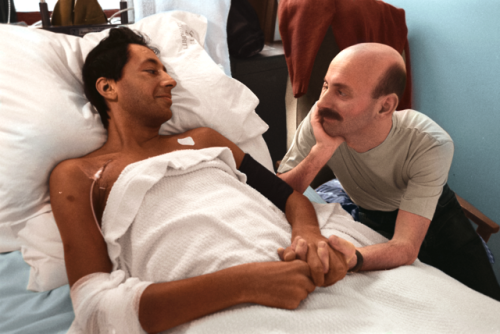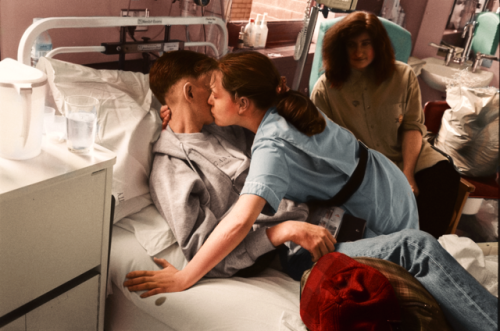Writing An Argument.
Any advice on back and forth dialogue? Like properly portraying an argument? I think all the spaces will get bothersome to the reader...
(Since arguments are the hardest type of back and forth dialogue to master, and other dialogue follows the same structure but in a more flexible manner, I’ll focus on arguments specifically…)
Writing an argument.
Everyone’s process for this is a little bit different, but here’s a look at mine, which has helped me reach the best end result (after many failed argument scenes in the past):
1. Dialogue. I like to write this as a script of sorts first, playing the scene in my head and only writing down the words and some vague comments regarding what the characters might be experiencing or doing. I leave breaks in the dialogue where the characters naturally pause from build ups of emotion, and add in all the em-dashes and ellipsis my heart desires (despite knowing a lot of them won’t make it through the reread, much less the final draft.)
2. Action. Not only does having your characters do things while they argue make the whole scene feel more realistic and plant it within the setting, but it also provides a great way for your characters to express things they don’t have the words to say. These “actions” can be facial expressions and body language, movement, or interaction with the objects in the setting, such as gripping a steering wheel too tightly or slamming a cupboard or tensely loading a gun.
3. Emotion. I save this for last because I find emotion very hard to write into narratives, but no matter when you write it or how you feel about it, feeling the pov character’s internal emotions is integral to the reader’s own emotional connection to the argument. Remember though, emotions should be shown and not told. Instead of saying the character is angry, describe what that anger is doing to them physically (how it makes them feel), and what desires it puts in them (how it makes them think.)
Other equally (if not more) important factors:
- Build tension slowly. Arguments will never be believable if the characters go from being calm and conversational to furious and biting in a single paragraph. The reader must feel the character’s anger build as their self-control dwindles, must hear the slight tension in their voice and the sharpness of their words as the scene leads up to the full blown argument.
- Vary sentence length. Arguments in which characters shoot single short sentences back and forth often feel just as stiff and unnatural as arguments where characters monologue their feelings for full paragraphs. If a character does need to say a lot of things in one go, break it up with short, emotional reactions from the other characters to keep the reader from losing the tension of the scene. Likewise, if characters don’t have bulk to their words, try including a few heavy segments of internal emotional turmoil from the pov character to make the argument hit harder instead of flying by without impact.
- Where did this argument start? Most arguments don’t really start the moment the words begin flying, but rather hours, days, weeks, even years before. If you as the author can’t pinpoint where the character’s emotions originated and what their primary target or release point is, then it’s unlikely the reader will accept that they exist in the first place.
- Characters want things, always. Sometimes arguments center around characters who vocally want opposing things, but often there are goals the characters hide or perhaps even from themselves. Think about what goals are influencing the characters in the argument while you’re writing it in order to make sure everything is consistent and focused.
Keep in mind that you don’t have to do all these things the very first draft. My arguments consistently have little emotion and even less build up until the second or third draft. As long as you return to these things as you continue to edit, the final result should feel like a fully fleshed out and emotional argument.
For more writing tips from Bryn, view the archive catalog or the complete tag!
More Posts from Lrs35 and Others
happy summer to dykes in tank tops and basketball shorts, goths who's makeup is melting, little kids catching frogs and fireflies, guys who just bring their guitar everywhere now, 13 yr olds very obviously in their emo phase during a family vacation, gas station employees, old people sitting on porches, and dogs swimming at the beach

Erika L. Sánchez, from “La Cueva”, Lessons on Expulsion
I think a lot about how we as a culture have turned “forever” into the only acceptable definition of success.
Like… if you open a coffee shop and run it for a while and it makes you happy but then stuff gets too expensive and stressful and you want to do something else so you close it, it’s a “failed” business. If you write a book or two, then decide that you don’t actually want to keep doing that, you’re a “failed” writer. If you marry someone, and that marriage is good for a while, and then stops working and you get divorced, it’s a “failed” marriage.
The only acceptable “win condition” is “you keep doing that thing forever”. A friendship that lasts for a few years but then its time is done and you move on is considered less valuable or not a “real” friendship. A hobby that you do for a while and then are done with is a “phase” - or, alternatively, a “pity” that you don’t do that thing any more. A fandom is “dying” because people have had a lot of fun with it but are now moving on to other things.
I just think that something can be good, and also end, and that thing was still good. And it’s okay to be sad that it ended, too. But the idea that anything that ends is automatically less than this hypothetical eternal state of success… I don’t think that’s doing us any good at all.

Hogwarts first year: PART 1
First semester, September to December





the humanity of the AIDS crisis: the ward by gideon mendel
colorized by me
for all of you guys getting anxious about the environment and pollution
y’all deserve to hear the good news too, and yes i fact checked these.
7 miles of habitat for bees will be planted in london
the biggest coal plant in north america has been converted to solar panels
roads in edinburgh will close once a month to help pollution
maine has banned styrofoam
new york city and los angeles have both made “green new deals”
The london marathon replaced 200,000 single use water bottles with seaweed water pods
the bees in notre dame survived the fire, and the roof could possibly built in a more eco-friendly way.
the population of flightless kakapos (a cool bird) is rising
the carbon emissions in the uk are the lowest they’ve been since 1998
Another large bee habitat (.5 mil acres) has been created
there is a robot that delivers young coral to help repopulate the great barrier reef
portugal plans to stop using plastic on fruit, vegetables, and bread by 2020
106 new species of bees have been discovered in australia since 2010
a group of Sikhs plan to plant 1,000,000 trees as a gift to the earth
disney has made a mickey-shaped solar farm
Morgan freeman turned a 124 acre ranch in mississippi to a bee habitat
China plans on making a “forest city” to help clean up their air
An increasing amount of countries and states are beginning to ban single use plastics.
A couple replanted a whole forest in brazil (2.7 mil trees) in 20 years, and the animals have come back to live there
The hole in the ozone layer is repairing itself more each year
China plans on spending 360 billion dollars to improve renewable energy and has scrapped plans for coal powered plants that were going to be built.
A national park has been built in the amazon (3.3 mil acres in peru) to preserve the rainforest
Ireland and the uk have declared a climate emergency
The guy who played aquaman (jason momoa) has spent 31,000 dollars to help clean up plastic
South korea is now recycling 95% of food waste
There is a cleanup campaign being planned for mt. everest
Puerto rico wants to use all renewable energy by 2050 and is setting official goals for that
Some schools have special water bottle fill-up stations that encourage you to use refill and reuse plastic bottles rather than throwing them out after one use, these are becoming more common.
9 endangered species are thought to make a comeback this year
20 countries in africa are planning to make a “green wall” of trees and plants that will span the width of africa to stop desertification
recently, a lot of volunteers and organizations are planting a ton of trees.
Awareness about the environment and climate change is growing super fast right now among people and countries, which will only help us
Most pollution is caused by like 100 companies, but a few of those (like pepsi) are trying to cut down on that.
if this stuff keeps happening things will get even better, and the only thing stopping us really are those big companies who don’t want to pay the money to switch to more eco-friendly energy sources. i know the media tends to cause fear and stress about this stuff for a lot of people, but there really is hope.
easy things we can do:
Recycle
Plant gardens in your yard for bees if you can
Participate in community volunteer things that plant trees and gardens
Theres this search engine called ecosia that plants a tree for every 45 searches you make, it has almost 2 mil users.
Pick up trash if you see it when you’re at the beach or in nature
If you have a fair amount of money, consider donating some to trustworthy environmental organizations
Start using a reusable water bottle (like those ones at target) rather than relying on single use plastic ones.
Cut the plastic rings on plastic milk bottles. You know, the little spiky plastic ring near the cap. Birds get those things stuck around their neck and die, so cut them so that they can’t get stuck on a neck.
If you can afford it, get some of those reusable grocery bags and sue those. most grocery stores have them, and it saves a lot of waste.
Alternate universe where I literally just to go to school forever (for free) so I can just learn about art and literature and history and languages for 100 years. No job skills. No credit requirements. No student loans. Just learning.
the show (going out to get groceries. making myself a nice dinner. showering and opening the windows. being kind to myself in everything i do) Must go on
What's your advice on writing a strong, solid chapter one? Something that will grab the reader's attention and make them beg on their knees for more?
Tips for Writing a Strong First Chapter
Note: in the examples, I’m using the second chapter as Harry Potter rather than the first, which was really more of a prologue.
1. Create a “snapshot” of your character’s normal life…
One of the most important things you can do in the first chapter is give your reader a sort of “snapshot” of your character’s life before the the inciting incident turns everything upside down. Otherwise, if we don’t know what their life is like before everything changes, the inciting incident won’t be a change. It’ll just be something that happens.
In Twilight, we saw Bella being the run-of-the-mill daughter of divorced parents. In Harry Potter, we saw Harry being the unwanted and much-maligned ward of muggle relatives, while struggling with emerging wizard powers. In Star Wars, we saw Luke being the bored farm boy, longing for heroism and adventure. In The Hunger Games, we saw Katniss taking care of her mom and sister by hunting for extra food for them with Gale.
2. Show us who they are–show us their strengths and their flaws…
Most stories feature a protagonist who changes in someway throughout the course of the story. This is the character arc, and it can either be positive (the most common) or negative. Positive story arcs stem from the character’s flaws that are established at the beginning of the story. While they have strengths, too, it’s the flaws that dominate and make their lives such a mess that the reader is anxious to see how their lives will change. The character will overcome those flaws through the events of the story, so in the end the reader can marvel at how far they’ve come and how much better their lives are as a result of this change. In a negative arc, it works in the exact opposite way. Sometimes there are static arcs, where the character doesn’t change but changes someone around them or their environment, and sometimes you get a little hybrid of both.
In Twilight, we see a girl who’s a little selfish, a little closed off, and very codependent. In The Hunger Games, we see a girl who feels helpless against the oppressive government making her life, and the lives of everyone she cares about, a living hell. In Star Wars, we see a boy who’s cocky and idealistic.
3. Show us who and what matters in their world…
Another important element that should be introduced in the first chapter is who and what matters to the main character. These are the initial stakes–the thing that motivates them into action when the world turns upside down. In some cases, the world turns upside down because something happened to them.
In Twilight, we meet Bella’s mom and dad, but in many ways, the absence of anyone else here is part of what serves as motivation for Bella to want her life to change and to want to belong to something bigger than herself. It’s much the same in Harry Potter, where the only people who really matter to him are people who died when he was a baby. In The Hunger Games, we meet Katniss’s mom and sister, her best friend Gale, and we learn about Katniss’s father and Gale’s family, and the boy with the bread. In Star Wars, we meet Luke’s Uncle Owen and Aunt Beru.
4. Show us their world…
Part of the point of the inciting incident is that it’s going to change the known world for the main character. This really dovetails with #1, because their normal life happens within this world. In some stories, a character’s “world” might be their work and home life or their home and school life. In other stories, their “world” might be the small village they live in and the plagued-by-evil-king kingdom the village is a part of.
In Twilight, Bella’s world was uprooted right at the beginning and exchanged for the tiny, perpetually overcast town of Forks, Washington. In The Hunger Games, Katniss’s world was District Twelve and the oppressive Capitol beyond. In Star Wars, Luke’s world was a moisture farm on the desert planet of Tatooine, part of a larger Civil War-wracked galaxy.
5. Start the story when something interesting is happening…
We often hear the advice “start in the middle of the action” or “begin the story with action” and this is often misinterpreted, either to mean you should start with the inciting incident or start with a big car chase or heart-pounding battle. Neither of which is true. Beginning the story with action just means you should start the story with something interesting happening rather than with a big info dump. That doesn’t mean you can’t include exposition in your opening, but weave the exposition into something interesting happening.
In Twilight, the story opens with Bella being dropped off at the airport by her mom so that she can move to Washington to live with her dad. In The Hunger Games, the story opens with Katniss getting ready to go hunting with Gale, then walking through her district on her way to meet him. In Harry Potter, we see Harry and the Dursleys getting ready for Dudley’s birthday party.
If you hit all five of these points in your first chapter, not only can you be sure to create a strong first chapter from which to launch the rest of your story, you can be sure your reader will have everything they need to start getting invested in your main character and the world around them. :)
-
 heckcareoxytwit liked this · 2 months ago
heckcareoxytwit liked this · 2 months ago -
 newdawnhorizon reblogged this · 2 months ago
newdawnhorizon reblogged this · 2 months ago -
 heckcareoxytwit reblogged this · 5 months ago
heckcareoxytwit reblogged this · 5 months ago -
 heckcareoxytwit reblogged this · 11 months ago
heckcareoxytwit reblogged this · 11 months ago -
 cool-validvenus-stuff liked this · 1 year ago
cool-validvenus-stuff liked this · 1 year ago -
 garfie-arbuck liked this · 1 year ago
garfie-arbuck liked this · 1 year ago -
 angelycake reblogged this · 1 year ago
angelycake reblogged this · 1 year ago -
 angelycake liked this · 1 year ago
angelycake liked this · 1 year ago -
 thatharringrovehoe liked this · 1 year ago
thatharringrovehoe liked this · 1 year ago -
 write-101 reblogged this · 1 year ago
write-101 reblogged this · 1 year ago -
 midnightyouths reblogged this · 2 years ago
midnightyouths reblogged this · 2 years ago -
 ourlordandsavioursauron liked this · 2 years ago
ourlordandsavioursauron liked this · 2 years ago -
 shoheisehun liked this · 2 years ago
shoheisehun liked this · 2 years ago -
 springcranes liked this · 2 years ago
springcranes liked this · 2 years ago -
 princessnefertankh liked this · 3 years ago
princessnefertankh liked this · 3 years ago -
 mean-and-serene liked this · 3 years ago
mean-and-serene liked this · 3 years ago -
 lustforlife11 liked this · 3 years ago
lustforlife11 liked this · 3 years ago -
 xsincerely liked this · 3 years ago
xsincerely liked this · 3 years ago -
 blurgayhero liked this · 3 years ago
blurgayhero liked this · 3 years ago -
 dragoonresources reblogged this · 3 years ago
dragoonresources reblogged this · 3 years ago -
 talkin-bout-dead-folks-main liked this · 3 years ago
talkin-bout-dead-folks-main liked this · 3 years ago -
 writingdrabbles202 liked this · 3 years ago
writingdrabbles202 liked this · 3 years ago -
 rainbowglittr reblogged this · 3 years ago
rainbowglittr reblogged this · 3 years ago -
 rainbowglittr liked this · 3 years ago
rainbowglittr liked this · 3 years ago -
 wonderluna liked this · 3 years ago
wonderluna liked this · 3 years ago -
 blissbins liked this · 4 years ago
blissbins liked this · 4 years ago -
 bellasaylim liked this · 4 years ago
bellasaylim liked this · 4 years ago -
 adersky liked this · 4 years ago
adersky liked this · 4 years ago -
 whatiswriting reblogged this · 4 years ago
whatiswriting reblogged this · 4 years ago -
 enter-clever-and-witty-url-here liked this · 4 years ago
enter-clever-and-witty-url-here liked this · 4 years ago -
 blushinsky liked this · 4 years ago
blushinsky liked this · 4 years ago -
 pareferencedump reblogged this · 4 years ago
pareferencedump reblogged this · 4 years ago -
 boddah-dreams liked this · 4 years ago
boddah-dreams liked this · 4 years ago -
 halfbloodliz liked this · 4 years ago
halfbloodliz liked this · 4 years ago -
 captaindina liked this · 4 years ago
captaindina liked this · 4 years ago -
 amazing-fandoms liked this · 4 years ago
amazing-fandoms liked this · 4 years ago -
 theatricdawn liked this · 4 years ago
theatricdawn liked this · 4 years ago -
 considermadness liked this · 4 years ago
considermadness liked this · 4 years ago

